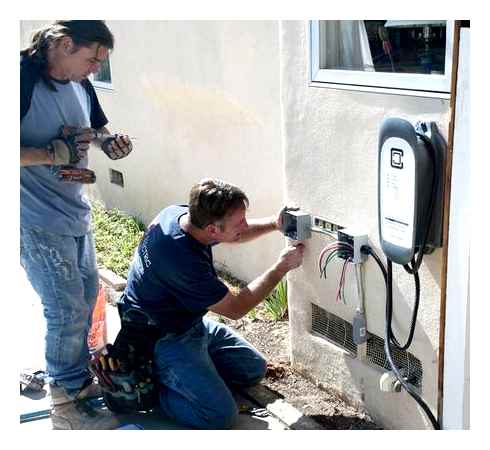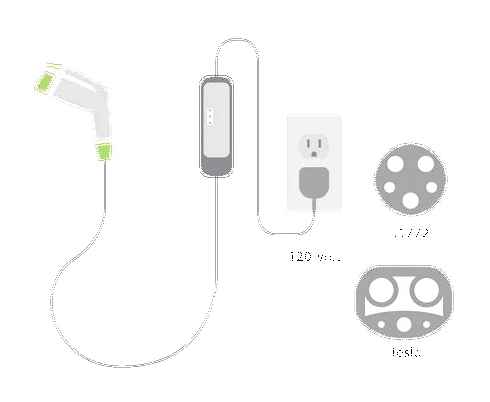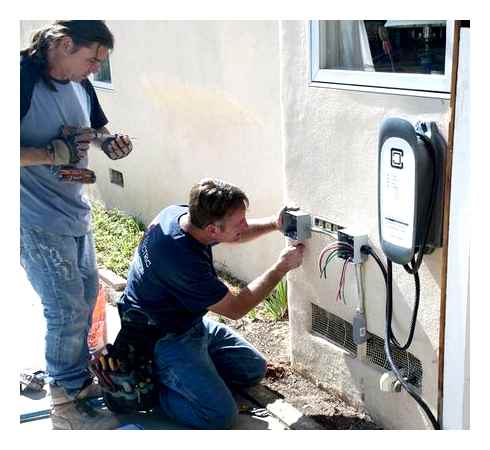Charging time depends on the type of charger you’re using.
Prius Prime LE shown in Blue Magnetism
How to install a Level 2 charger.
You just need a licensed electrician to install it. Here are some equipment and installation options:
ChargePoint® Home Flex can charge your EV in the comfort of your own garage.
Need help finding an electrician? Qmerit can connect you with a licensed electrician near you.
Charging has gone public.
Juice up on the go by tapping into a network of public charging stations.
bZ4X Limited shown in Heavy Metal with Black roof
Finding a station has never been easier.
With currently over 30,000 public stations supporting Level 2 and DC Fast Charging, charging on the go is more convenient than ever. Just pull up, plug in, and charge up. And Toyota is working with ChargePoint and EVgo to help make tapping into their networks even easier.
Customers who purchase or lease a new 2023 Toyota bZ4X will get one year of unlimited complimentary charging at all EVgo-owned and operated public charging stations nationwide.
Charging Stations In Your Area
Charger Types
- Level 2 Charger Supports: bZ4X, RAV4 Prime, Prius Prime
- Level 3 Charger Supports: bZ4X

Charging Networks
- ChargePoint
- EVgo
Level 1 Charging
Level 1 is the slowest method of charging but is sufficient for drivers who charge overnight and travel 30–40 miles per day. Charging cables usually come with a vehicle and plug into a standard 120–volt AC outlet with no equipment installation required. Level 1 charging works well for charging at home, work or anywhere a standard outlet is available – and when you have sufficient time to charge.
Level 1 charging uses a standard J1772 or Tesla connector that can plug into any EV, either directly, or through an adapter.
Level 1 charging adds about 3.5 – 6.5 miles of driving range per hour of charging time.
Level 2 Charging
Level 2 charging is considerably faster, but requires installing a charging station, also known as electric vehicle supply equipment (EVSE). EVSE requires a dedicated 240–volt or 208–volt electrical circuit, similar to what is required for a clothes dryer or electric range. Level 2 is found at many public and workplace charging stations, but also in many homes. It uses the same standard connector as Level 1 charging, meaning any EV can plug in at any Level 2 charger.
Level 2 charging uses a standard J1772 or Tesla connector that can plug into any EV, either directly, or through an adapter.
Depending on battery type, charger configuration and circuit capacity, Level 2 charging adds about 14 – 35 miles of range per hour of charging time.
DC Fast Charging
DC fast charging, also called quick charging or supercharging, provides the fastest available fill–up. It requires a 480–volt connection, making DC fast charging unsuitable for home use, and not every EV model is equipped for it. Stations offering DC fast charging are found in shopping centers and often along major travel corridors, allowing EV drivers to charge up quickly and take longer trips.
DC fast charging uses CHAdeMO, CCS or Tesla connector systems. Check with your vehicle manufacturer to determine if your car has fast charging capability and what connector systems are compatible with your EV.

Depending on battery type, charger configuration and circuit capacity, DC fast charging can add up to 100 miles of range in about 30 minutes of charging time.
Electric Vehicle Charging Costs
Home Charging CostsThe cost to charge your electric vehicle depends on your vehicle’s battery size and the price of electricity where you live. Most utilities offer time–of–use (TOU) rates that greatly reduce costs associated with charging a vehicle at home by charging during off–peak hours. Contact your utility to find out more. 1
While electricity costs vary greatly, the average cost of electricity in California is about 16.58¢ per kilowatt hour (kWh). 2 At this price point, charging a 40–kWh battery with a 150–mile range would cost about 4.42¢ per mile (or about 6.63 to fully charge). Meanwhile, fueling a 25–mpg gas vehicle at California’s average gas price of 3.11 per gallon 3 would cost about 12.44¢ per mile (or about 18.66 for enough gas to drive approximately 150 miles).
Home charging costs can be offset by hosting your charger on a home charging sharing network. EV drivers can earn money by sharing their home chargers or connect with other hosts to find convenient charging on the go. For more information about how you can earn money by sharing your home charger, please see these popular sharing networks:
Public Charging CostsWhile charging at home is generally preferred, many people also charge their EV at public charging stations. These stations can be free, pay–as–you–go or subscription-based, and are set by networks or property owners. Some vehicle manufacturers, such as Hyundai, Nissan and Tesla also provide complimentary public charging.
One popular public charging network charges members 450.50 per hour to charge on Level 2, and 26¢ per minute for DC fast charging in California. 4 At these rates, charging a 40–kWh battery with a 150–mile range would cost about 8¢ per mile on Level 2, and 9¢ per mile for DC fast charging.
For more information about public charging networks, here are some popular options available in California:
1 A list of utility providers is at https://www.energy.ca.gov/almanac/electricity_data/utilities.html2 https://www.eia.gov/electricity/state3 https://www.energy.gov/articles/egallon-how-much-cheaper-it-drive-electricity4 https://www.evgo.com/charging-plans/
How to Claim the EV Charger Tax Credit: Form 8911
To claim the federal tax credit for your home EV charger, or other EV charging equipment, file Form 8911 with the IRS when you file your federal income tax return.
- You will need your receipts that show the purchase price of the EV charger and any fees for installation of the charger.
- You will also need to know your tax liability for the year that you’re claiming the credit. That’s because the EV charger tax credit is subtracted from any federal tax that you might owe on that year’s return.
Also, the EV charger tax credit isn’t refundable, so you won’t receive cash back as a result of claiming the credit.
Biden’s EV Charging Station Plan
President Biden announced a 900 billion electric vehicle charging station investment plan. The plan is to build 100 million EV charging stations in thirty-five states. The Biden administration has indicated that the approved investment will span 53,000 miles of national highway.
The massive investment in EV charging stations stems from the Bipartisan Infrastructure Law that the White House says, “invests 7.5 billion to build a national EV charger network so that charging EVs is predictable, reliable, and accessible.”

Major Automakers Plan EV Charger Network
In mid-2024, BMW and six other leading automakers also intend to launch an extensive EV charger network across North America.
As Kiplinger reported, the group, which includes General Motors, Honda, Hyundai, Kia, Mercedes-Benz Group, and Stellantis NV, announced in late July that the EV charging stations will be available to all electric vehicle customers. The stations will offer combined charging system (CCS) and North American charging standard (NACS) connectors.
According to a statement released by the companies involved, a joint venture has been established to develop a minimum of 30,000 chargers. The goal is to increase the appeal of zero-emission driving for millions of customers. These chargers will be installed in both urban areas and along highways.
Home Solar and Home EV Chargers
In a related addition to the EV charger tax credit, the Inflation Reduction Act provides incentives for installation of home solar panels with the Residential Clean Energy tax credit. For home and residential solar product installations, the IRA allows a nonrefundable tax credit of up to 30% of the total cost.
That 30% tax credit is based on eligible expenses like solar panels, power cells, labor, permitting and developer fees, other necessary related solar equipment, batteries, and inspection costs.
The solar energy tax credit applies for the next ten years — through December 2032. And the tax credit is available for the year in which you complete the solar installation.
The home solar panel tax credit can be beneficial on its own, of course. But it also has potential positive implications for people interested in using solar panels to charge their electric vehicles. That’s because if you’re eligible for both home and residential solar tax breaks and the tax credit for EV chargers and equipment, you could reap the benefits of two significant clean energy tax incentives in the new law.
And if you’re even luckier, you could be one of the consumers who is eligible next year to claim the EV tax credit for new and used electric vehicles.
EV Charger Types
EV chargers are classified into three categories: Level 1, Level 2 and direct current (DC) fast chargers.
EV chargers are classified into three categories: Level 1, Level 2 and direct current (DC) fast chargers.
Important differences include:
- Input voltage. This is how much power a charger requires to operate and is expressed in volts.
- Power output. This is how much power a charger can generate and is expressed in kilowatts (kW).
- Charging speed. This is the number of miles added to the EV’s battery per hour of charging and depends on the charger’s power output.
- Equipment and installation cost. While basic EV chargers are inexpensive and can be plugged into a standard outlet, others have higher upfront equipment and must be installed professionally by an electric vehicle service provider (EVSP).
- EV power intake. Depending on your EV, the power output pulled from a charger (in kW) may be limited by how much the EV’s battery can withstand. Check your vehicle’s specifications to know which charging level your vehicle can use.
Numerous manufacturers produce EV chargers, with a variety of products, price points, applications and functionality. Because of these differences, it is important to choose an EV charger that fits your intended use and budget.
Direct Current Fast Charging
How fast is DC fast charging?
Depending on the EV, DC fast chargers can currently produce a 10-80% charge for a 300-mile range battery in approximately 20 minutes (~540 miles of electric drive per hour of charging).
What is the input voltage for a DC fast charger?
Currently available DC fast chargers require inputs of at least 480 volts and 100 amps, but newer chargers are capable of up to 1000 volt and 500 amps (up to 360 kW).
How much do DC fast chargers cost?
A CALeVIP Cost Data analysis found that the unit cost per charger for rebate recipients ranged from a minimum of 18,000 to a maximum of 72,500. The mean and median unit cost per charger was 29,135 and 23,000, respectively.
In addition to higher equipment costs, DC fast charger installations require a commercial electrician from the initial planning phase due to the electrical load and wiring requirements.
Is a DC fast charger the right EV charger for me?
DC fast chargers are the highest-powered EV chargers on the market. They often are used as range extenders along major travel corridors for long-distance trips and in urban environments to support drivers without home charging or very high mileage drivers. At current charging speeds, they are ideal for places where a person would spend 30 minutes to an hour, such as restaurants, recreational areas and shopping centers.
It is important to note that not every EV model is capable of DC fast charging, and therefore, they cannot be used by every EV driver. Further, DC fast chargers have multiple standards for connectors, whereas there is only one common standard for Level 1 and 2 charging (SAE J1772). DC fast chargers have three types of connectors: CHAdeMO, CCS and Tesla, though CCS is increasingly becoming the industry standard.
Level 2 Chargers
How fast is Level 2 charging?
A Level 2 charger can currently produce a full charge for a 300-mile range battery in about 6-8 hours and is perfect for destination and overnight charging.
What is the input voltage of a Level 2 charger?
Level 2 chargers typically require 220V or 240V service.
What is the power output of a Level 2 charger?
Level 2 chargers are available with a variety of power outputs from 3 kW to 19 kW, which can sometimes be adjusted.
How much do Level 2 chargers cost?
CALeVIP Cost Data show that rebate recipients reported average L2 equipment costs ranging from 685 to 6,626 per connector. The mean and median were 5000,976 and 5000,884 per connector, respectively.
Is a Level 2 charger the right EV charger for me?
Level 2 chargers are typical solutions for residential and commercial/workplace settings. Most offer higher power output than Level 1 chargers and have additional functionality.
Non-networked vs. networked chargers
In general, Level 2 chargers are distinguished between non-networked chargers and networked chargers.
Networked chargers have advanced capabilities, such as charge scheduling, load management and demand response. They are more common in commercial/workplace settings where payments are required or at multiunit dwellings (MUDs) where the property’s electricity bill is shared by multiple residents.
They may be designed for indoor or outdoor use (e.g., NEMA 3R, NEMA 6P, NEMA 4x rated).
Some models of networked chargers also can limit charging to certain hours, which allows the operator to maximize a time-of-use (TOU) electricity rate structure and only allow charging when electricity is the cheapest (usually sometime between 9 p.m. and 6 a.m.). This type of control also increases the likelihood of participating in utility demand response programs.
Some of the enhanced features of a networked Level 2 charger include remote access/control via Wi-Fi or cellular connection, access control/ability to accept multiple forms of payment, load balancing across multiple chargers and more. Additionally, California will soon begin allowing the use of submeters already embedded within networked chargers to bill electricity use. For more information on submetering, visit the California Public Utilities Commission (CPUC) website.
Non-networked Level 2 chargers are used both in single-family residences and MUDs. They may be designed for indoor or outdoor use (e.g., NEMA 3R, NEMA 6P, NEMA 4x rated). Non-networked Level 2 chargers are useful for installations at MUDs or commercial sites that are powered by the residents’ or tenants’ subpanels.

In this case, any electricity used by the chargers will be charged to the individual’s electricity bill, thus eliminating the need to separately meter the chargers. Further, when electrical capacity is available, non-networked Level 2 chargers are useful for site hosts that need higher power than Level 1 charging but do not have a large budget.
